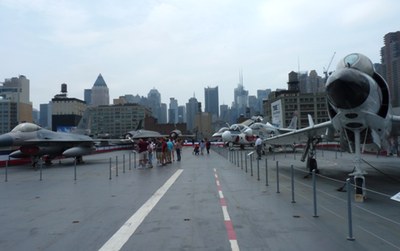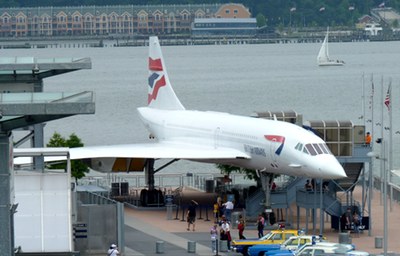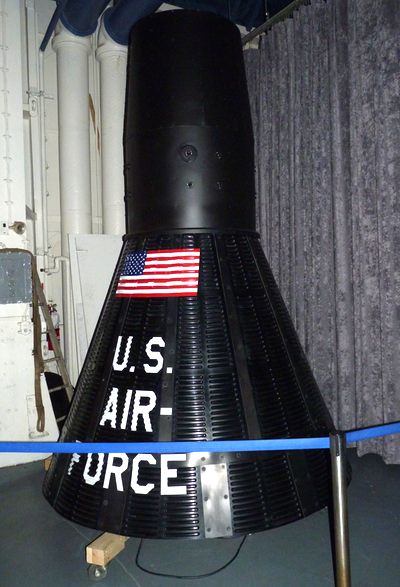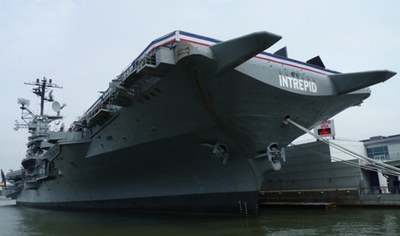An Intrepid quest for a shuttle in New Yorkby Jeff Foust
|
| The biggest selling point for locating a shuttle in New York is that, well, it’s New York. |
Conventional wisdom has it that the likely recipients of the other two shuttles will be the Kennedy Space Center and the Johnson Space Center (or, more specifically, the commercially-operated visitors centers for those two centers). Both are already major tourist attractions, and both include among their collections Saturn 5 rockets, refurbished after years of outdoor storage and located now in modern indoor facilities. Both have also expressed their interest in obtaining an orbiter. Earlier this month, for example, Space Center Houston issued a press release noting plans to expand the center to incorporate the shuttle as part of efforts to promote science education. “Space science is abstract and a challenge for many students to comprehend,” said Richard Allen, president and CEO of the center, in the release. “The presence of a space shuttle would serve as the catalyst to promote understanding and inspiration.”
The Cape and Houston, though, are hardly the only candidates vying for an orbiter. Nearly 20 museums and other centers have responded to NASA’s request for information (RFI) about obtaining a retired orbiter. While they don’t have the same deep space roots as KSC and JSC, most make the case of having strong links to space, or at least aerospace, in some manner, and all have stepped up lobbying efforts. The Museum of Flight in Seattle, whose CEO is former astronaut Bonnie Dunbar, is breaking ground this week on a new “Space Gallery” that will be capable of hosting a shuttle. Last week the Seattle City Council unanimously passed a resolution asking NASA to give one of the shuttles to the museum. The Air Force Museum in Dayton, Ohio, is also actively seeking a shuttle, and has rounded up letters of support from people ranging from members of Congress to former astronauts to the Secretary of the Air Force. Even Tulsa, Oklahoma, a city not widely considered a major space city, has a former astronaut, John Herrington, leading its dark-horse bid for a shuttle as it gathers regional support and plays up the aviation and space heritage of the city (see “Rocket racers, shuttles, and Tulsa”, The Space Review, April 26, 2010)
And then there’s New York City, which is also seeking a shuttle orbiter. While it may be the largest city in the US and a world leader in business, finance, and media, it’s never had the reputation of being a major center of aerospace activity. There are, of course, exceptions to this, most notably the Apollo lunar landers built by Grumman Corporation on Long Island 40 years ago, but New York has never been associated with aerospace in the public imagination in the same way as Cape Canaveral or Houston, or for that matter Seattle or Dayton. Ironically, though, the biggest selling point for locating a shuttle in New York is that, well, it’s New York.
 The Manhattan skyline serves as the backdrop to military aircraft arrayed on Intrepid’s flight deck. (credit: J. Foust) |
“New York City would make an ideal home for one of these retiring shuttles,” notes the web site of the Intrepid Sea, Air, and Space Museum, which seeks to host the orbiter. The site is vague on why exactly the Big Apple is so ideal, but arguments tend to revolve around the city’s existing large tourism industry. “I can think of no better place to showcase the space program and America’s innovation to the world than New York,” said local congressman Jerrold Nadler (D-NY), at an event at the museum in March to kick off a new push for support for the museum’s bid. “As America’s most cosmopolitan city, New York would be the perfect venue to display this iconic space craft.”
| As a sea and air museum—two-thirds of its title—the Intrepid isn’t bad. As a space museum, though, the Intrepid falls short. |
“Locating a shuttle at the Intrepid has been called a ‘no-brainer’—and we couldn’t agree more,” Bill White, president of the museum at the time of the event, said. “With millions of American and foreign tourists visiting New York City every year, putting a shuttle at the Intrepid would create an ideal platform to share our national pride in our space program with the entire world, pay tribute to the men and women who have played a role in our greatest technological achievement, and provide an opportunity to educate future generations on the exploration of space.”
Few would disagree with the claim that placing a shuttle in New York has the potential to attract a far larger number of tourists than, say, Dayton or Tulsa. But what about the quality of the site that will host the shuttle: how does the museum stack up with other space-related museums and centers around the country? In that respect, New York’s standing isn’t nearly as secure.
The Intrepid is a World War 2-era aircraft carrier that served in the US Navy for three decades. In 1982 it became a museum, docked at Pier 86 on the Hudson River, a modest walk from Times Square in the heart of Manhattan. The ship and pier completed $120-million, two-year renovation in 2008. The museum complex also includes a submarine, the Growler, as well as a Concorde aircraft.
As a sea and air museum—two-thirds of its title—the Intrepid isn’t bad. The carrier’s flight desk has an assortment of military airplanes and helicopters, ranging from an F-14 to a MiG-21 to an A-12 Blackbird (the precursor to the SR-71); other museums may have more extensive collections, but without the iconic Manhattan skyline as a backdrop. The hangar deck below is home to a variety of exhibits, and of course the ship itself is an exhibit: visitors can explore many sections of the vessel, from the bridge to the anchor chain room in the fo’c’s’le.
 A Concorde sits on the end of Pier 86 adjacent to the Intrepid. The Concorde would be moved down the pier to make way for a glass hangar that would house a shuttle orbiter. (credit: J. Foust) |
As a space museum, though, the Intrepid falls short. The museum makes some mention of the role the ship played as a recovery vessel; while museum literature describes the Intrepid as “a primary spacecraft recovery vessel during the 1960s”, the carrier actually participated in only two recovery operations: Mercury 7 (Aurora 7) in 1962 and Gemini 3 in 1965. However, there’s not much in the way of permanent exhibits, the most prominent of which is a replica of the Aurora 7 capsule (the actual Aurora 7 capsule is on display at the Museum of Science and Industry in Chicago).
| Tucked away in a dark corner near the rear of the flight deck is what appears to be a Gemini capsule. It’s as if the museum hadn’t quite decided where and how to display the capsule. |
During a mid-June visit the museum had two temporary space-related exhibits on display. One, “Mission to Mars”, which closes at the end of this month, features a full-scale replica of the Mars Exploration Rover and a few other displays in the museum’s “Exploreum” section of hands-on exhibits (the rover, though, not being one of them.) The other, “27 Seconds”, which opened June 12, recounts the Apollo 1 tragedy. The exhibit, though, is more tell than show: there’s plenty of text mounted on placards lining the exhibit’s walls describing the accident and its aftermath, as well as some photos, but little in the way of actual artifacts associated with Apollo 1. Most of what is on display comes from the family of one the Apollo 1 astronauts, Roger Chaffee, including a flight jacket and a telegram reporting his death. One could learn just as much, if not more, about the accident by reading its Wikipedia entry.
Then there’s the case of the mystery capsule. Tucked away in a dark corner near the rear of the flight deck, by the hallway leading to restrooms and the fantail, is what appears to be a Gemini capsule. However, the capsule, standing upright on a plain wooden base, doesn’t feature NASA insignia but instead “U.S. AIR- FORCE” (hyphen included) and a US flag. There’s no description of the capsule on display, and unlike the Aurora 7 replica, it’s not listed in the visitor’s guide or other museum documents. As it turns out, early last year the museum obtained a replica of the Gemini 3 spacecraft (although photos of it show it show it with generic US and not USAF insignia). It’s as if the museum, more than a year later, hadn’t quite decided where and how to display the capsule.
 What appears to be a replica of a Gemini capsule, but with Air Force markings, sits in a dark corner of the Intrepid’s flight deck, without any displays or other information about it. (credit: J. Foust) |
The museum, at least, has figured out where it will put a shuttle should NASA provide it with one. They’ve released illustrations of a glass-enclosed structure that would be located at the end of the pier adjacent to the Intrepid (a spot currently occupied by the Concorde). The structure would include platforms to give visitors a variety of vantage points to view the orbiter, as well as room for additional exhibits. The structure also satisfies a NASA requirement for a “suitable climate-controlled indoor facility” for displaying the shuttle.
| NASA has given precious little information on how it will evaluate proposals for hosting shuttles, beyond “making placement decisions that are determined to be in the best interest of the American taxpayer.” |
While the museum continues to collect signatures for a petition asking for a shuttle (a display in the Intrepid’s hangar desk features cards people can sign and deposit, as well as several mailbags presumably filled with such signed cards) that publicity push in the spring has died down. During that time one local newspaper, the Daily News, was running one story a day for about a week about the Intrepid’s quest for a shuttle. That effort was topped off by a publicity stunt where politicians and members of the public, some of the latter dressed in NASA flight suits (and, in one case, an ill-fitting Star Trek tunic) rode the “shuttle”—the subway’s S train that shuttles between Grand Central Station and Times Square. In addition, the museum has had to deal with the sudden, unexplained (at least publicly) resignation last month of Bill White, its president.
It’s not clear, though, how effective any of these publicity and lobbying measures, by New York or other cities, will be in procuring an orbiter. The NASA RFI asks respondents to describe “the benefit to the Nation of displaying a Space Shuttle Orbiter at your facility”, including how it would “inspire the American public and students in particular”, in addition to technical details about displaying the orbiter and how it will pay for it (winning facilities would have to pay NASA $28.8 million to prepare and transport each orbiter, on top of its own costs of preparing the display facilities.) However, it gives precious little information on how it will evaluate that information, beyond “making placement decisions that are determined to be in the best interest of the American taxpayer.”
So how would putting a shuttle in New York, versus another US city, be in the “best interest of the American taxpayer”? There’s no doubt that it would be a major tourist attraction, and perhaps attract a portion of the public who wouldn’t ordinarily think of going to KSC or JSC. But there’s also a more fundamental question that the Intrepid or any other museum seeking a shuttle has to ask: just how inspirational, particularly to students, is something that was once symbolic of our future in space but is now about to be a discarded piece of the past?
